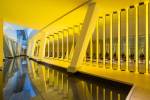Frank Gehry has been making headlines recently, both for the opening of his newest creation, the Louis Vuitton Foundation in Paris, and for his unfortunate middle-finger gesture in response to a journalist’s question at a press conference in Spain. The journalist had asked him to comment on the suggestion that his designs are pure ‘spectacle’.
Gehry has since apologised, blaming jet-lag for his response. But the question remains, and is brought into sharp focus as the foundation opens with spectacular fanfare.
The new structure comprises 11 differently shaped galleries, an auditorium, four viewing terraces, a shop and a restaurant, all encompassed by enormous glass ‘sails’. It has also been described as a ‘cloud of glass’. Billboards at the metro station Sablons, the nearest transport link to the Foundation, are plastered with adverts of the building floating in a blue haze.
In reality the location is more down to earth: the leafy Bois de Boulogne, alongside the Jardin d’acclimation, a charming old-fashioned amusement park for children. The Bois and the park both came into being during Napoleon III’s reign (1852–70). Gehry’s playful architecture is a nod to the location’s history of leisure pursuits, and the extraordinary glass structure harks back to the (ahem) spectacle of Second Empire and Belle Époque Paris.
But despite the enormity of the structure – and crowds of visitors – the space itself retains a sense of calm and lightness. Inside the artworks are displayed in a sparse, straightforward way. A simple wall text is given for each artist without any of the pompous art-speak and tortuous theorising that can ruin the experience of contemporary art. Works from the foundation’s collection (which features Gerhard Richter, Ellsworth Kelly, Bertrand Lavier and Pierre Huyghe amongst others) appear refreshingly un-curated.
Other artists have been commissioned to create works especially for the new space, including a dizzying kaleidoscope installation by Olafur Eliasson. There are also displays that celebrate the building itself. An exhibition of maquettes leads visitors through Gehry’s creative process, while in the basement galleries a film by Sarah Morris (with music by Liam Gillick) follows the construction of the foundation and an installation by Taryn Simon ‘uncovers the memory of the construction site’.
It is interesting to glimpse the work that went on in the making of the extraordinary edifice, but the mise en abyme of Gehry’s creation becomes a bit self-congratulatory, particularly while a new retrospective of Gehry’s work is also open at the Pompidou Centre. The show, which includes sketches, maquettes and videos, charts his career from early residences (including the extension of his own house in Santa Monica) to ‘starchitect’ status with the Guggenheim Bilbao in the 1990s.
The exhibition highlights two interwoven strands of Gehry’s practice: the creative impulse evident in his squiggly-lined sketches and almost child-like models, and the ground-breaking digital technologies developed to engineer them. These strands culminate in the undulating forms of the Louis Vuitton Foundation itself, the research for which was conducted by some 200 engineers, and resulted in 30 patents for new technology.
This being France, there has been hand-wringing over whether the new foundation – which was commissioned by Bernard Arnault – represents an unnecessarily decadent monument to wealth in a time of economic crisis. The French president François Hollande has called the new foundation ‘a gift to France’, but a recent open letter signed by French intellectuals bemoaned the increasing grip of the private sector on the art world. It’s probably too early to call, but if there’s one thing Parisians do like, it’s spectacle.
‘Frank Gehry’ is at the Fondation Louis Vuitton, Paris, until 16 March 2015.
A retrospective of the Gehry’s work is open at the Centre Pompidou until 26 January 2015.










